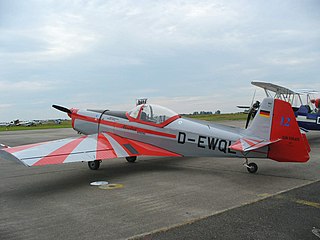
The PZL-Mielec M-18 Dromader is a single engine agricultural aircraft that is manufactured by PZL-Mielec in Poland. The aircraft is used mainly as a cropduster or firefighting machine.

The CAP Aviation CAP-23x family is a family of aircraft designed for competition aerobatics. The CAP 230 airframe was a direct development of the CAP 21 competition single seater strengthened to cope with a 300 hp (220 kW) 6-cylinder Lycoming AEIO-540 engine instead of the 200 hp (150 kW) original 4-cylinder Lycoming AEIO-360.

The Pitts Special is a series of light aerobatic biplanes designed by Curtis Pitts. It has accumulated many competition wins since its first flight in 1944. The Pitts biplanes dominated world aerobatic competition in the 1960s and 1970s and, even today, remain potent competition aircraft in the lower categories.

The PZL-Mielec M-20 Mewa is a licence-built version of the Piper PA-34 Seneca II manufactured in Poland by WSK PZL Mielec in a limited series from the 1980s.

The Grob G 120 is a two-seat training and aerobatic low-wing aircraft with a carbon composite airframe, built by Grob Aircraft. It is based on the Grob G 115TA training aircraft and is specially designed for military and civil pilots training. It has a tricycle landing gear and a low tailplane.

The PZL M28 Skytruck is a family of Polish light utility aircraft with STOL capability produced by PZL Mielec for military and civilian use. They are mainly used in transport, patrol and maritime reconnaissance roles.

The PZL-101 Gawron (rook) is a Polish agricultural and utility aircraft designed and built by WSK-Okęcie.

The LWD Szpak (starling) was a Polish utility aircraft of 1945, the first Polish aircraft designed after World War II and built in a short series.

The PZL-106 Kruk is a Polish agricultural aircraft designed and built by WSK PZL Warszawa-Okęcie.
The PZL M-24 Dromader Super is a single engine agricultural aircraft, developed in the 1980s by the WSK-Mielec from the PZL-Mielec M-18 Dromader. It did not progress beyond the prototyping stage.

The PZL-105 Flaming (flamingo) is a Polish short-takeoff-and-landing (STOL) utility aircraft designed by PZL "Warszawa-Okęcie". It remained a prototype.

The Mudry CAP 10 is a two-seat training aerobatic aircraft first built in 1970 and still in production in 2007. The plane was developed from the Piel Super Emeraude and was born as the CP100. The name changed to CAP 10, CAP for 'Constructions Aéronautiques Parisiennes'. The CAP 10 was manufactured by Mudry in Bernay, France, bought by CAP Industries which then became Apex Aircraft. Following the bankruptcy of Apex in 2008, rights to produce spares were awarded to Dyn'Aviation. After the bankruptcy of DynAero in 2012, manufacture of spares was taken over by CEAPR in Darois.

The Zlin Z-526 Akrobat is a Czech sports plane used in aerobatics.

The AS/SA 202 Bravo is a two to three-seat civil light aircraft jointly designed and manufactured by the Swiss company Flug- und Fahrzeugwerke Altenrhein (FFA) and the Italian company Savoia-Marchetti. The aircraft was designated the AS 202 in Switzerland, and the SA 202 in Italy.

The Christen Eagle, which later became the Aviat Eagle in the mid-1990s, is an aerobatic sporting biplane aircraft that has been produced in the United States since the late 1970s.

The PZL-102 Kos (blackbird) is a Polish two-seat touring and training monoplane designed and built by PZL.

The PZL M-17 "Duduś Kudłacz" was a Polish twin-boom pusher general aviation and trainer aircraft of 1977, which remained a prototype.

PZL M-2 was a Polish trainer aircraft prototype of 1958, a low-wing monoplane with fixed gear. Designed at WSK-Mielec, it did not enter production.

The PZL M-24 Dromader Mini, originally named the Lama, is a single engine agricultural aircraft, developed in the 1980s by WSK-Mielec from the PZL-Mielec M-18 Dromader. The prototype, registration SP-PDM, first flew on 18 June 1982. It did not progress beyond the prototyping stage.
The Tech Aero TR 200 is a French homebuilt aerobatic aircraft that was designed and produced by Tech Aero of Glisolles, first flown in August 1988. When it was available the aircraft was supplied as a kit for amateur construction.


















